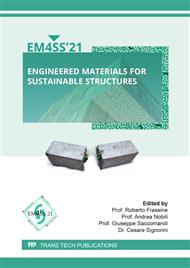[1]
M. Sovetova, S.A. Memon, J. Kim, Thermal performance and energy efficiency of building integrated with PCMs in hot desert climate region, Sol. Energy. 189 (2019) 357–371.
DOI: 10.1016/j.solener.2019.07.067
Google Scholar
[2]
A. Credo, A. Cristofari, S. Lucidi, F. Rinaldi, F. Romito, M. Santececca, M. Villani, Design Optimization of Synchronous Reluctance Motor for Low Torque Ripple BT - A View of Operations Research Applications in Italy, 2018, in: M. Dell'Amico, M. Gaudioso, G. Stecca (Eds.), Springer International Publishing, Cham, 2019: p.53–69.
DOI: 10.1007/978-3-030-25842-9_5
Google Scholar
[3]
W. Zhu, Z. Zhang, X. Li, W. Feng, J. Li, Assessing the effects of technological progress on energy efficiency in the construction industry: A case of China, J. Clean. Prod. 238 (2019) 117908.
DOI: 10.1016/j.jclepro.2019.117908
Google Scholar
[4]
B.-E. Benzar, M. Park, H.-S. Lee, I. Yoon, J. Cho, Determining retrofit technologies for building energy performance, J. Asian Archit. Build. Eng. 19 (2020) 367–383.
DOI: 10.1080/13467581.2020.1748037
Google Scholar
[5]
R.D. Muddu, D.M. Gowda, A.J. Robinson, A. Byrne, Optimisation of retrofit wall insulation: An Irish case study, Energy Build. 235 (2021) 110720.
DOI: 10.1016/j.enbuild.2021.110720
Google Scholar
[6]
M. Kameni Nematchoua, P. Ricciardi, S. Reiter, A. Yvon, A comparative study on optimum insulation thickness of walls and energy savings in equatorial and tropical climate, Int. J. Sustain. Built Environ. 6 (2017) 170–182.
DOI: 10.1016/j.ijsbe.2017.02.001
Google Scholar
[7]
D. D'Agostino, F. de' Rossi, M. Marigliano, C. Marino, F. Minichiello, Evaluation of the optimal thermal insulation thickness for an office building in different climates by means of the basic and modified cost-optimal, methodology, J. Build. Eng. 24 (2019) 100743.
DOI: 10.1016/j.jobe.2019.100743
Google Scholar
[8]
A. Bolattürk, Determination of optimum insulation thickness for building walls with respect to various fuels and climate zones in Turkey, Appl. Therm. Eng. 26 (2006) 1301–1309.
DOI: 10.1016/j.applthermaleng.2005.10.019
Google Scholar
[9]
V. Annibaldi, F. Cucchiella, M. Rotilio, A Sustainable Solution for Energy Efficiency in Italian Climatic Contexts, Energies. 13 (2020) 2817.
DOI: 10.3390/en13112817
Google Scholar
[10]
M.F. Alsayed, R.A. Tayeh, Life cycle cost analysis for determining optimal insulation thickness in Palestinian buildings, J. Build. Eng. 22 (2019) 101–112.
DOI: 10.1016/j.jobe.2018.11.018
Google Scholar
[11]
V. Annibaldi, F. Cucchiella, P. De Berardinis, M. Rotilio, V. Stornelli, Environmental and economic benefits of optimal insulation thickness: A life-cycle cost analysis, Renew. Sustain. Energy Rev. 116 (2019) 109441.
DOI: 10.1016/j.rser.2019.109441
Google Scholar
[12]
N. Sisman, E. Kahya, N. Aras, H. Aras, Determination of optimum insulation thicknesses of the external walls and roof (ceiling) for Turkey's different degree-day regions, Energy Policy. 35 (2007) 5151–5155.
DOI: 10.1016/j.enpol.2007.04.037
Google Scholar
[13]
J. Yu, C. Yang, L. Tian, D. Liao, A study on optimum insulation thicknesses of external walls in hot summer and cold winter zone of China, Appl. Energy. 86 (2009) 2520–2529.
DOI: 10.1016/j.apenergy.2009.03.010
Google Scholar
[14]
Ö.A. Dombaycı, The environmental impact of optimum insulation thickness for external walls of buildings, Build. Environ. 42 (2007) 3855–3859.
DOI: 10.1016/j.buildenv.2006.10.054
Google Scholar
[15]
K. Çomaklı, B. Yüksel, Environmental impact of thermal insulation thickness in buildings, Appl. Therm. Eng. 24 (2004) 933–940.
DOI: 10.1016/j.applthermaleng.2003.10.020
Google Scholar
[16]
T.M.I. Mahlia, A. Iqbal, Cost benefits analysis and emission reductions of optimum thickness and air gaps for selected insulation materials for building walls in Maldives, Energy. 35 (2010) 2242–2250.
DOI: 10.1016/j.energy.2010.02.011
Google Scholar
[17]
ISO 15686-5:2017, Buildings and constructed assets-Service-life planning. 5. Life-cycle costing, (2017).
DOI: 10.3403/30184346
Google Scholar
[18]
UNI/TR 11552:2014, Opaque envelope components of buildings, (2014).
Google Scholar
[19]
UNI 10351:2015, Materiali e prodotti per edilizia - Proprietà termoigrometriche - Procedura per la scelta dei valori di progetto, (2015).
Google Scholar
[20]
ARERA, Prices, (2021). https://www.arera.it/it/index.htm.
Google Scholar
[21]
A. Kylili, P.A. Fokaides, Policy trends for the sustainability assessment of construction materials: A review, Sustain. Cities Soc. 35 (2017) 280–288.
DOI: 10.1016/j.scs.2017.08.013
Google Scholar
[22]
R. Idchabani, A. Khyad, M. El Ganaoui, Optimizing insulation thickness of external walls in cold region of Morocco based on life cycle cost analysis, Energy Procedia. 139 (2017) 117–121.
DOI: 10.1016/j.egypro.2017.11.183
Google Scholar
[23]
J. Yu, L. Tian, C. Yang, X. Xu, J. Wang, Optimum insulation thickness of residential roof with respect to solar-air degree-hours in hot summer and cold winter zone of china, Energy Build. 43 (2011) 2304–2313.
DOI: 10.1016/j.enbuild.2011.05.012
Google Scholar
[24]
O. Kaynakli, A review of the economical and optimum thermal insulation thickness for building applications, Renew. Sustain. Energy Rev. 16 (2012) 415–425.
DOI: 10.1016/j.rser.2011.08.006
Google Scholar
[25]
A. Appolloni, C.J. Chiappetta Jabbour, I. D'Adamo, M. Gastaldi, D. Settembre-Blundo, Green recovery in the mature manufacturing industry: The role of the green-circular premium and sustainability certification in innovative efforts, Ecol. Econ. 193 (2022) 107311.
DOI: 10.1016/j.ecolecon.2021.107311
Google Scholar
[26]
F. Ascione, N. Bianco, G. Maria Mauro, D.F. Napolitano, Building envelope design: Multi-objective optimization to minimize energy consumption, global cost and thermal discomfort. Application to different Italian climatic zones, Energy. 174 (2019) 359–374.
DOI: 10.1016/j.energy.2019.02.182
Google Scholar
[27]
F.F. Cyrille Vincelas, T. Ghislain, The determination of the most economical combination between external wall and the optimum insulation material in Cameroonian's buildings, J. Build. Eng. 9 (2017) 155–163.
DOI: 10.1016/j.jobe.2016.12.008
Google Scholar
[28]
A. Appolloni, I. D'Adamo, M. Gastaldi, E.D.R. Santibanez-Gonzalez, D. Settembre-Blundo, Growing e-waste management risk awareness points towards new recycling scenarios: The view of the Big Four's youngest consultants, Environ. Technol. Innov. 23 (2021) 101716.
DOI: 10.1016/j.eti.2021.101716
Google Scholar
[29]
M.S. Medina-Salgado, F.E. García-Muiña, M. Cucchi, D. Settembre-Blundo, Adaptive Life Cycle Costing (LCC) Modeling and Applying to Italy Ceramic Tile Manufacturing Sector: Its Implication of Open Innovation, J. Open Innov. Technol. Mark. Complex. 7 (2021) 101.
DOI: 10.3390/joitmc7010101
Google Scholar
[30]
A.M. Ferrari, L. Volpi, D. Settembre-Blundo, F.E. García-Muiña, Dynamic life cycle assessment (LCA) integrating life cycle inventory (LCI) and Enterprise resource planning (ERP) in an industry 4.0 environment, J. Clean. Prod. 286 (2021) 125314.
DOI: 10.1016/j.jclepro.2020.125314
Google Scholar
[31]
S. Alonso-Muñoz, R. González-Sánchez, C. Siligardi, F.E. García-Muiña, Building Exploitation Routines in the Circular Supply Chain to Obtain Radical Innovations, Resources. 10 (2021) 22.
DOI: 10.3390/resources10030022
Google Scholar


